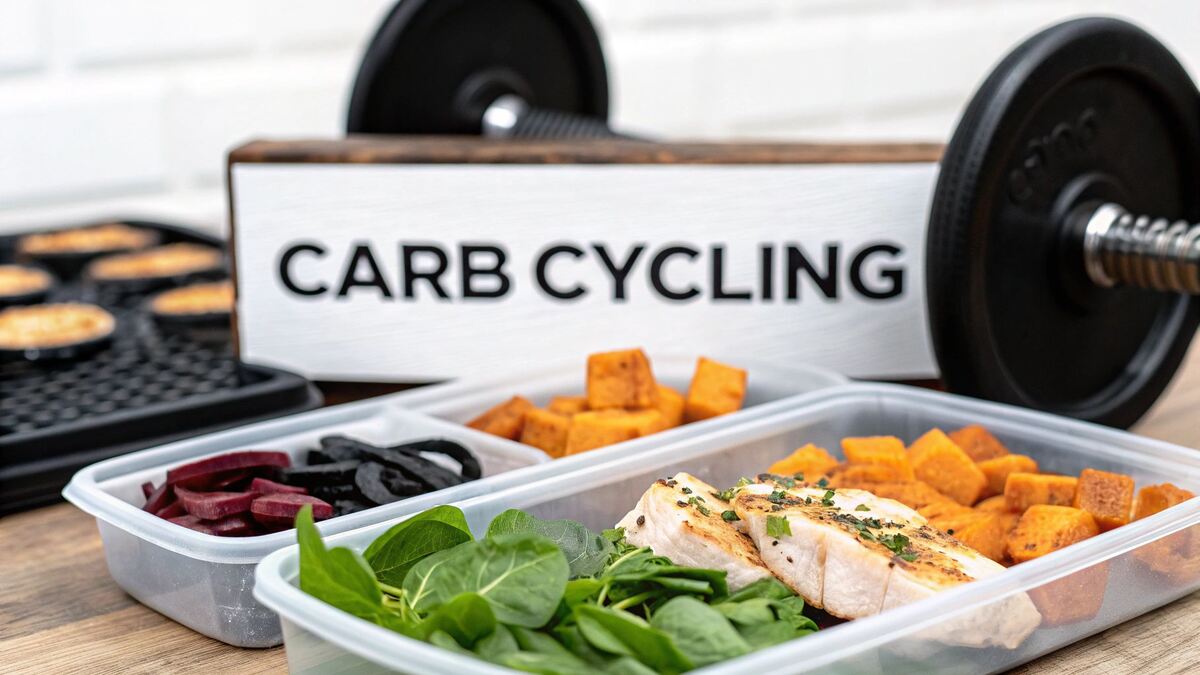Carb Cycling for Fat Loss Explained
Carb cycling is a pretty intuitive way to eat for fat loss. At its core, it's about matching your fuel to your workload. You’ll eat more carbs on the days you train hard and scale them back on days you’re resting or doing lighter activity. The goal is to give your body energy when it needs it most, and encourage it to burn fat when it doesn't.
How Carb Cycling Actually Burns Fat
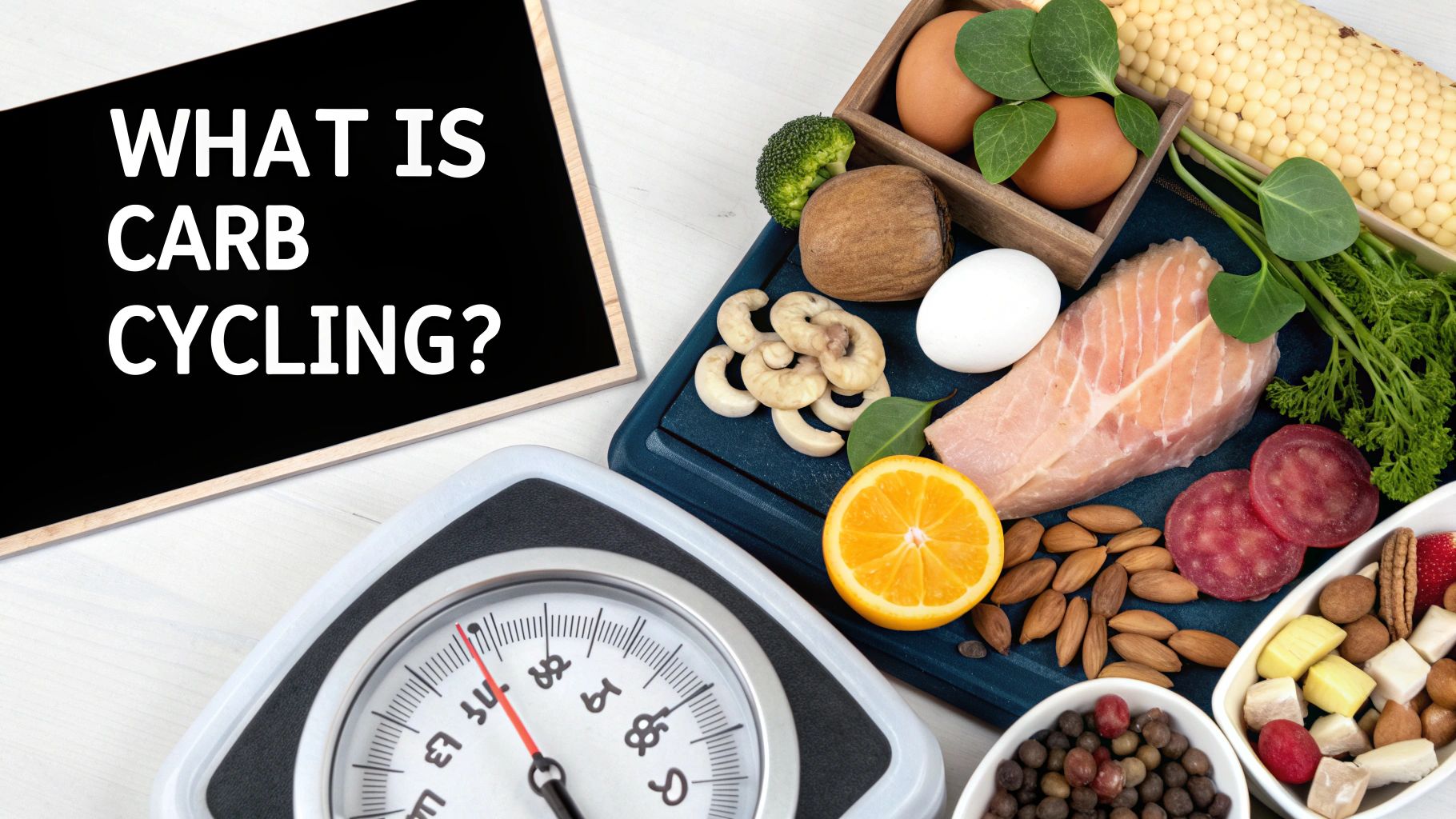
Unlike diets that demand constant restriction, carb cycling is more of a dynamic approach. You’re not treating every day the same because, let’s face it, they aren’t. It’s like having a smart fuel management system for your body.
When you're powering through a tough workout—think heavy squats or intense sprints—your body’s go-to fuel is glycogen. This is just stored carbohydrate in your muscles and liver. High-carb days are planned specifically for these demanding sessions to make sure your glycogen tanks are full. This gives you the instant energy you need to perform at your best and helps you recover faster afterward.
Then you have your rest days or light activity days. Your energy demand plummets, so these become your low-carb days. By cutting back on carbs, you force your body to burn through its stored glycogen and switch over to its secondary fuel source: body fat. This metabolic flip-flop is reallyx the key to making carb cycling work for fat loss.
The Hormonal Edge You Get From Cycling Carbs
The real genius of this approach is how it manipulates key hormones that control everything from hunger and energy to fat storage. The two big ones to know are insulin and leptin.
- Managing Insulin: Insulin’s job is to move glucose (from carbs) out of your bloodstream and into your cells for energy. That’s a good thing, but chronically high insulin levels can signal your body to store more fat. Your low-carb days help improve your insulin sensitivity, which means your body gets better at this process and doesn't need to release as much insulin.
- Regulating Leptin: Often called the "satiety hormone," leptin tells your brain when you’re full and helps keep your metabolism running smoothly. When you diet for too long by restricting carbs or calories, leptin levels can crash. This triggers intense hunger and slows your metabolism way down. Your high-carb days act as a strategic reset, bumping leptin levels back up to keep you feeling satisfied and your metabolic rate fired up.
By switching between high and low-carb days, you get the best of both worlds. You reap the fat-burning rewards of a low-carb diet but dodge the nasty side effects like tanked performance, muscle loss, and the metabolic slowdown that often sabotage long-term progress.
Beating the Dreaded Metabolic Adaptation
One of the most frustrating parts of any diet is hitting a plateau. This happens because of metabolic adaptation—your body gets wise to what you’re doing and becomes more efficient, burning fewer calories over time as a survival instinct.
Carb cycling is a fantastic tool for outsmarting this. Those periodic high-carb days send a powerful signal to your body that food is abundant, preventing it from flipping the "starvation mode" switch. This keeps your thyroid hormones and overall metabolism humming along, which leads to more consistent, sustainable fat loss.
Ultimately, the whole process is rooted in how our bodies are designed to use fuel. As documented in resources on Healthline.com, the science shows that high-carb days replenish the muscle glycogen you need for performance while also managing hormones that control hunger. On the flip side, low-carb days push your body to become more efficient at burning fat. It’s not just about what you eat, but when you eat it.
Calculating Your Personal Carb Cycling Macros
Alright, let's get down to the numbers. This is where the theory of carb cycling becomes your personal, actionable plan for losing fat. We're going to walk through exactly how to calculate your macronutrient targets for your high, medium, and low carb days. No guesswork, just a clear roadmap.
The first thing we need to figure out is how much energy your body actually uses each day. Forget those generic online calculators; we'll establish a solid starting point that we can tweak as we go.
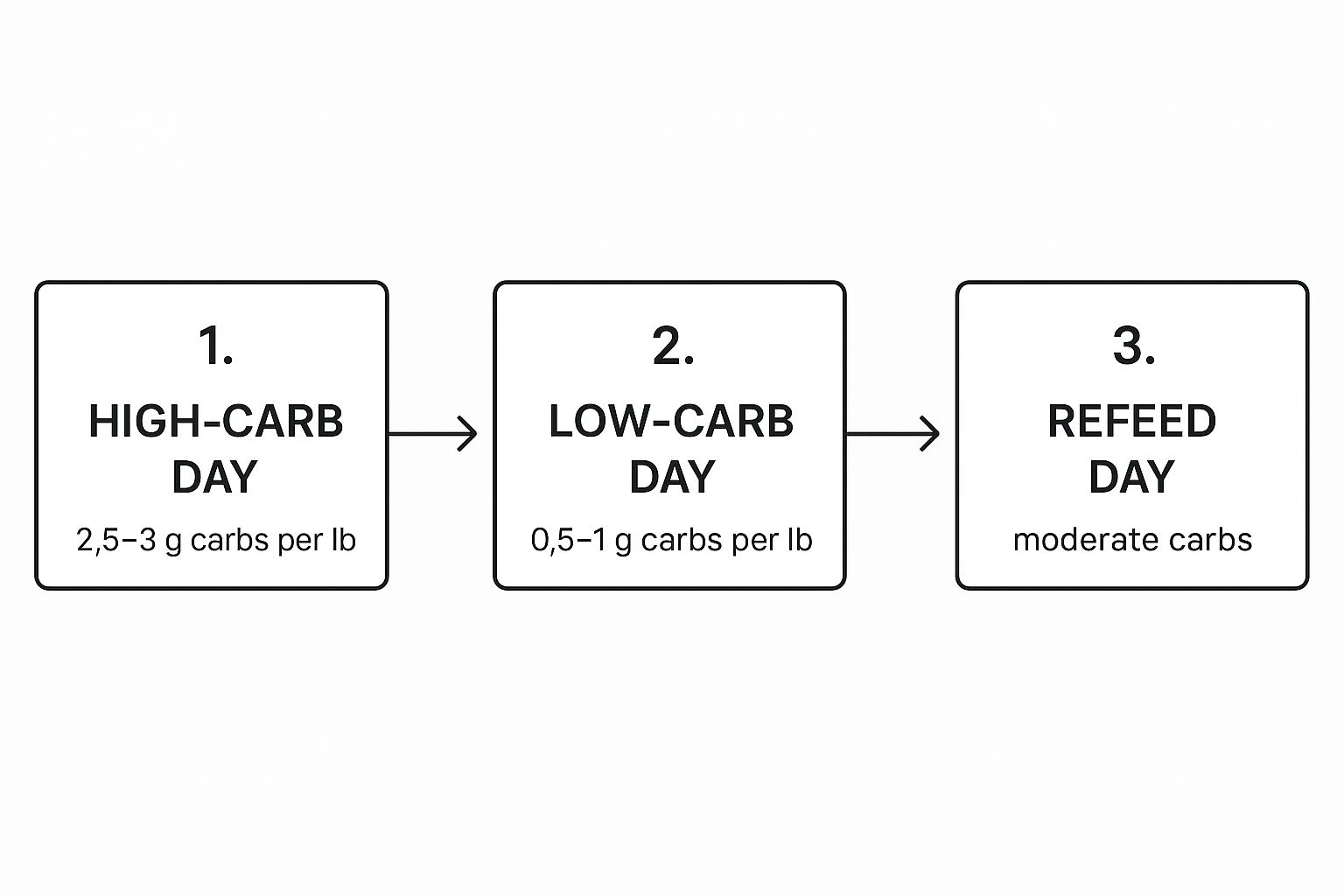
This simple breakdown shows the core idea: carbs go up and down depending on what you're doing that day. High-carb days fuel tough workouts, while low-carb days crank up fat burning. Notice how the other macros stay put? That’s the key to making this whole thing manageable.
Establishing Your Calorie Baseline For Fat Loss
Before we even think about carbs, we need to know your maintenance calories—what you need to eat to stay at your current weight. A really practical way to estimate this is to take your body weight in pounds and multiply it by 14-16.
If you're mostly sedentary, stick closer to 14. If you're hitting the gym hard most days, use 16.
Let's run through an example with a 170-pound person who is moderately active. We'll use a multiplier of 15.
- 170 lbs x 15 = 2,550 calories
That’s their maintenance level. To trigger fat loss, we need to be in a calorie deficit. A 15-20% reduction is a great, sustainable place to start. Let's go with 20% for this example.
- 2,550 calories x 0.20 = 510 calories to cut.
- 2,550 - 510 = 2,040 calories per day.
So, 2,040 calories is our average daily target for fat loss. This number will be the anchor for the entire plan.
Setting Your Consistent Macros Protein and Fat
With our calorie target locked in, the next move is to set your protein and fat intake. Think of these as the foundation of your diet—they stay the same every single day, which makes meal prep and planning so much easier.
Protein: Set your goal at 1 gram of protein per pound of body weight. This is non-negotiable. It helps you hold onto precious muscle while you're dieting, which keeps your metabolism from tanking. Plus, your body burns more calories just digesting protein.
- 170 lbs x 1 g/lb = 170 grams of protein
Fat: You'll want to aim for 0.3 to 0.4 grams of fat per pound of body weight. Healthy fats are crucial for hormone function and overall health. We'll split the difference and use 0.35.
- 170 lbs x 0.35 g/lb = 60 grams of fat (rounded)
Now, let's see what that looks like in calories. Protein has 4 calories per gram, and fat packs 9 calories per gram.
- Protein Calories: 170g x 4 cal/g = 680 calories
- Fat Calories: 60g x 9 cal/g = 540 calories
Your Non-Negotiables: Whether it's a high-carb day or a low-carb day, you’re hitting 170g of protein and 60g of fat. Together, these provide 1,220 calories (680 + 540) that form the bedrock of your daily nutrition.
Calculating Your Variable Carb Intake
Here's the fun part: figuring out your carbs. The calories left over after we account for your protein and fat will all come from carbohydrates. Since carbs also have 4 calories per gram, the math is straightforward.
We'll set up three different types of days:
High-Carb Days: Save these for your most grueling workouts, like a heavy leg day. We’ll aim to eat at or even slightly above maintenance to refill muscle glycogen and kickstart recovery. Let's set this day at 2,500 calories.
Medium-Carb Days: Perfect for moderate training days or just days you're more active. We'll set this right at our fat-loss average of 2,040 calories.
Low-Carb Days: These are your rest days or light activity days. The goal here is to maximize your body's ability to burn fat for fuel. We'll drop the calories to 1,600.
Let's do the math for each day.
High-Carb Day Calculation:
- Total Calories: 2,500
- Subtract Protein + Fat Calories: 1,220
- Remaining Calories for Carbs: 2,500 - 1,220 = 1,280 calories
- Carbs in Grams: 1,280 / 4 = 320 grams
Medium-Carb Day Calculation:
- Total Calories: 2,040
- Subtract Protein + Fat Calories: 1,220
- Remaining Calories for Carbs: 2,040 - 1,220 = 820 calories
- Carbs in Grams: 820 / 4 = 205 grams
Low-Carb Day Calculation:
- Total Calories: 1,600
- Subtract Protein + Fat Calories: 1,220
- Remaining Calories for Carbs: 1,600 - 1,220 = 380 calories
- Carbs in Grams: 380 / 4 = 95 grams
To make this crystal clear, here’s how the numbers look side-by-side for our 170 lb example.
Sample Macro Calculations for a 170 lb Individual
This table shows how the macros shift across the different days. As you can see, only the carbohydrates change, while protein and fat remain constant anchors in your plan.
| Day Type | Carbohydrates (g) | Protein (g) | Fat (g) | Total Calories |
|---|---|---|---|---|
| High-Carb | 320 | 170 | 60 | 2,500 |
| Medium-Carb | 205 | 170 | 60 | 2,040 |
| Low-Carb | 95 | 170 | 60 | 1,600 |
By going through this process, you’ve built a completely personalized framework for carb cycling for fat loss. It’s a system that adapts to your daily needs, making it not only incredibly effective but also much easier to stick with for the long haul.
Designing a Schedule That Fits Your Life
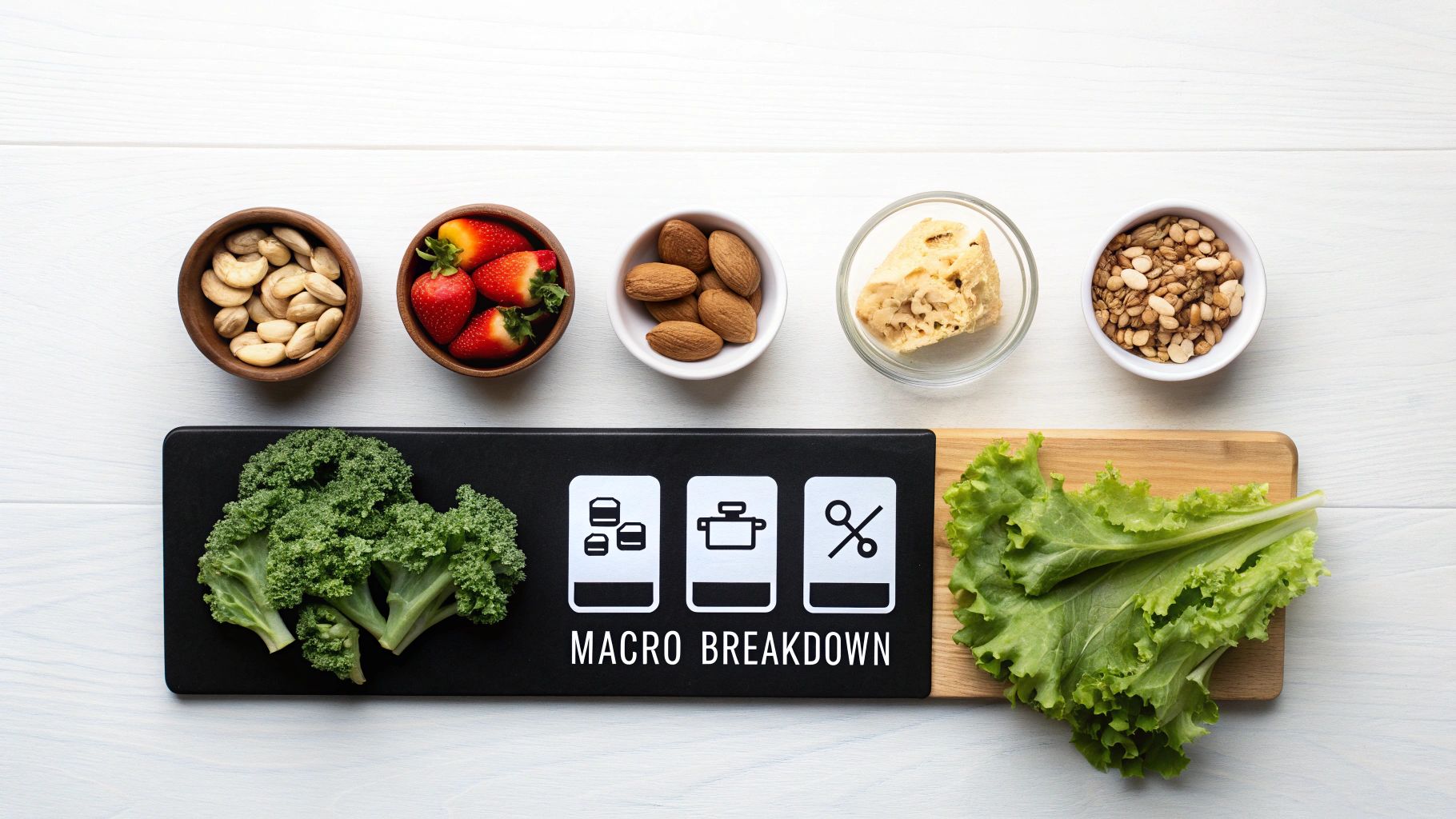
Alright, you've got your macro numbers. Now for the fun part: putting them into action. This is where the strategy really comes to life, and it's less about a perfect plan on paper and more about what genuinely works for you.
A carb cycling schedule has to mesh with your real-world routine. If it feels like a constant battle against your work schedule, training, and social life, it's not going to last. The goal is to build a sustainable rhythm, not a restrictive chore.
Matching Your Carbs to Your Training Intensity
The most common—and for good reason, most effective—way to set up your week is by lining up your carb intake with your training. Simple, right? You put the fuel where the work is.
This approach ensures you have the energy to crush your hardest workouts and recover properly, all while maximizing fat-burning on your easier days.
Think about your weekly training split. When are you pushing the hardest? For most of us, that’s going to be on heavy lifting days, especially for big muscle groups like legs and back.
Let’s walk through a real-world example for someone who lifts four times a week:
- Monday (Heavy Leg Day): High-Carb Day
- Tuesday (Light Cardio/Active Recovery): Low-Carb Day
- Wednesday (Heavy Upper Body Day): High-Carb Day
- Thursday (Rest Day): Low-Carb Day
- Friday (Full Body Workout): Medium-Carb Day
- Saturday (Moderate Activity/Weekend Fun): Medium-Carb Day
- Sunday (Rest Day): Low-Carb Day
This kind of structure isn't just theory; it’s backed by solid results. A five-month controlled study showed that people combining this kind of diet cycling with exercise saw incredible reductions in weight and fat mass. The average loss was about 10.7 pounds of body weight and 7.7 pounds of fat, all without tanking their resting metabolism. You can dig into the specifics of this study on how structured cycling supports fat loss goals for yourself.
By aligning your fuel with your effort, you’re not just dieting—you’re strategically programming your body for better performance and recovery. Food becomes a tool to hit your goals more efficiently.
Alternative Carb Cycling Schedules
Look, aligning carbs perfectly with your training is the gold standard, but it’s not the only way to do it. Life happens, and sometimes a simpler, more predictable structure is what you need to stay on track.
The "High-Low" Split
This is about as straightforward as it gets. You just alternate between high-carb and low-carb days. It's a fantastic option if your workout schedule is a bit unpredictable or if you're just getting started.
- Monday: High-Carb
- Tuesday: Low-Carb
- Wednesday: High-Carb
- Thursday: Low-Carb
- ...and you just keep that pattern going.
This creates a consistent calorie deficit over the week while still giving you the metabolic perks of cycling. It might be less optimized for peak performance on any given day, but its simplicity makes it incredibly easy to stick with.
The "Weekend Refeed" Model
Do you live for the weekends? This schedule might be your best friend. It involves keeping carbs low during the week and then bringing them back up on Saturday and Sunday.
- Weekdays (Mon-Fri): Low-Carb Days
- Weekend (Sat-Sun): High-Carb Days
This model can be a game-changer for social events and helps the diet feel much less restrictive. The key here is to try and schedule your toughest workouts for the weekend to put those extra carbs to good use.
Ultimately, the best schedule is the one you can see yourself following not just for a week, but for the long haul. Consistency will always trump perfection.
Building Your Carb Cycling Meal Plan
Alright, you've got your macro targets and a weekly schedule. Now for the fun part: turning those numbers into actual, delicious meals. This is where the rubber meets the road, and the concept of carb cycling for fat loss really comes to life on your plate.
Let's be honest, a plan is only as good as the food you're willing to eat day in and day out. We'll walk through what a full day of eating looks like for both high-carb and low-carb days, so you can see how to hit your targets without feeling like you're on a bland, miserable diet.
What to Eat on a High-Carb Day
Think of high-carb days as fuel days. You’re strategically using carbohydrates to power through tough workouts and restock the glycogen in your muscles. This isn't a free pass to hit the donut shop; we’re talking about quality, complex carbohydrates that provide sustained energy.
Your meals should be centered around a solid lean protein source, a generous portion of starchy carbs, and a good serving of veggies.
For our 170 lb example person who's aiming for 320g of carbs, a day might look something like this:
- Breakfast: A big bowl of oatmeal made with water, mixed with a scoop of protein powder and topped with a banana and a handful of berries.
- Lunch: A grilled chicken breast next to a large sweet potato, with a side of steamed broccoli and sliced bell peppers.
- Pre-Workout: A cup of Greek yogurt with a little honey drizzled on top.
- Dinner: Lean ground turkey mixed into a whole-wheat pasta with a simple tomato sauce, served with a large garden salad.
- Evening Snack: A small bowl of brown rice with some black beans.
What to Eat on a Low-Carb Day
On your low-carb days, we flip the script completely. By dialing back the starchy carbs and sugars, you encourage your body to tap into stored body fat for fuel. The menu shifts to focus heavily on lean proteins, healthy fats, and mountains of fibrous, non-starchy vegetables.
These days are all about maximizing your body's fat-burning environment. Your plate will look very different—less dense carbs, more leafy greens.
For that same person, now targeting just 95g of carbs, the day could look like this:
- Breakfast: A few scrambled eggs cooked with spinach and mushrooms, with half an avocado on the side.
- Lunch: A massive salad loaded with mixed greens, cucumber, tomatoes, and grilled salmon, dressed simply with olive oil and vinegar.
- Snack: A handful of almonds and some celery sticks.
- Dinner: A baked cod fillet served with roasted asparagus and a side of cauliflower rice.
See the difference? We've swapped out the oats, potatoes, and pasta for more veggies, nuts, and healthy fats. Protein becomes the star of the show to keep you feeling full. Finding convenient snacks that fit these low-carb days can be a game-changer, so it's worth reading up on choosing the best protein bars for weight loss.
The secret to surviving low-carb days is eating for volume. Pile your plate high with fibrous veggies like broccoli, spinach, and zucchini. They have very few carbs but fill you up, preventing that empty-stomach feeling without wrecking your macros.
To make the contrast even clearer, here’s a side-by-side comparison of a full day's meals. Notice how the core protein often stays the same, but the surrounding carb and fat sources are what really change.
High-Carb vs. Low-Carb Day Meal Comparison
| Meal | High-Carb Day Example | Low-Carb Day Example |
|---|---|---|
| Breakfast | Oatmeal with protein powder, banana & berries | Scrambled eggs with spinach & avocado |
| Lunch | Grilled chicken, large sweet potato & broccoli | Large salad with grilled salmon & olive oil dressing |
| Snack | Greek yogurt with honey | Handful of almonds & celery sticks |
| Dinner | Turkey with whole-wheat pasta & tomato sauce | Baked cod with asparagus & cauliflower rice |
This table shows just how much the food choices shift to hit those specific daily targets. It's all about making smart swaps.
Your Food Selection Toolkit
The meal plans above are just templates. The real success comes from building a plan with foods you actually like to eat. If you hate it, you won't stick with it. It’s that simple.
Use this list as a starting point. Feel free to mix and match different items to create your own meals that align with your macro goals for the day.
| Protein Sources | Healthy Fat Sources | High-Carb Choices (Starchy) | Low-Carb Choices (Fibrous) |
|---|---|---|---|
| Chicken Breast | Avocado & Avocado Oil | Oats (Rolled or Steel-Cut) | Spinach & Kale |
| Turkey Breast | Olive Oil | Brown & White Rice | Broccoli & Cauliflower |
| Lean Beef (93/7) | Nuts (Almonds, Walnuts) | Sweet & White Potatoes | Asparagus & Green Beans |
| Salmon & Cod | Seeds (Chia, Flax, Pumpkin) | Quinoa | Bell Peppers & Onions |
| Eggs & Egg Whites | Nut Butters | Whole-Grain Bread & Pasta | Zucchini & Cucumber |
| Greek Yogurt | Fatty Fish (e.g., Salmon) | Beans & Lentils | Mushrooms & Brussels Sprouts |
This flexibility is key. Tired of sweet potatoes? Swap in an equal portion of quinoa. Not in the mood for salmon? Have a lean steak instead. This ability to adapt is precisely what makes carb cycling a sustainable approach to losing fat.
If you want to take the guesswork out of it entirely, an AI-powered meal planner can create customized recipes and grocery lists based on these exact principles.
Avoiding Common Mistakes and Pitfalls
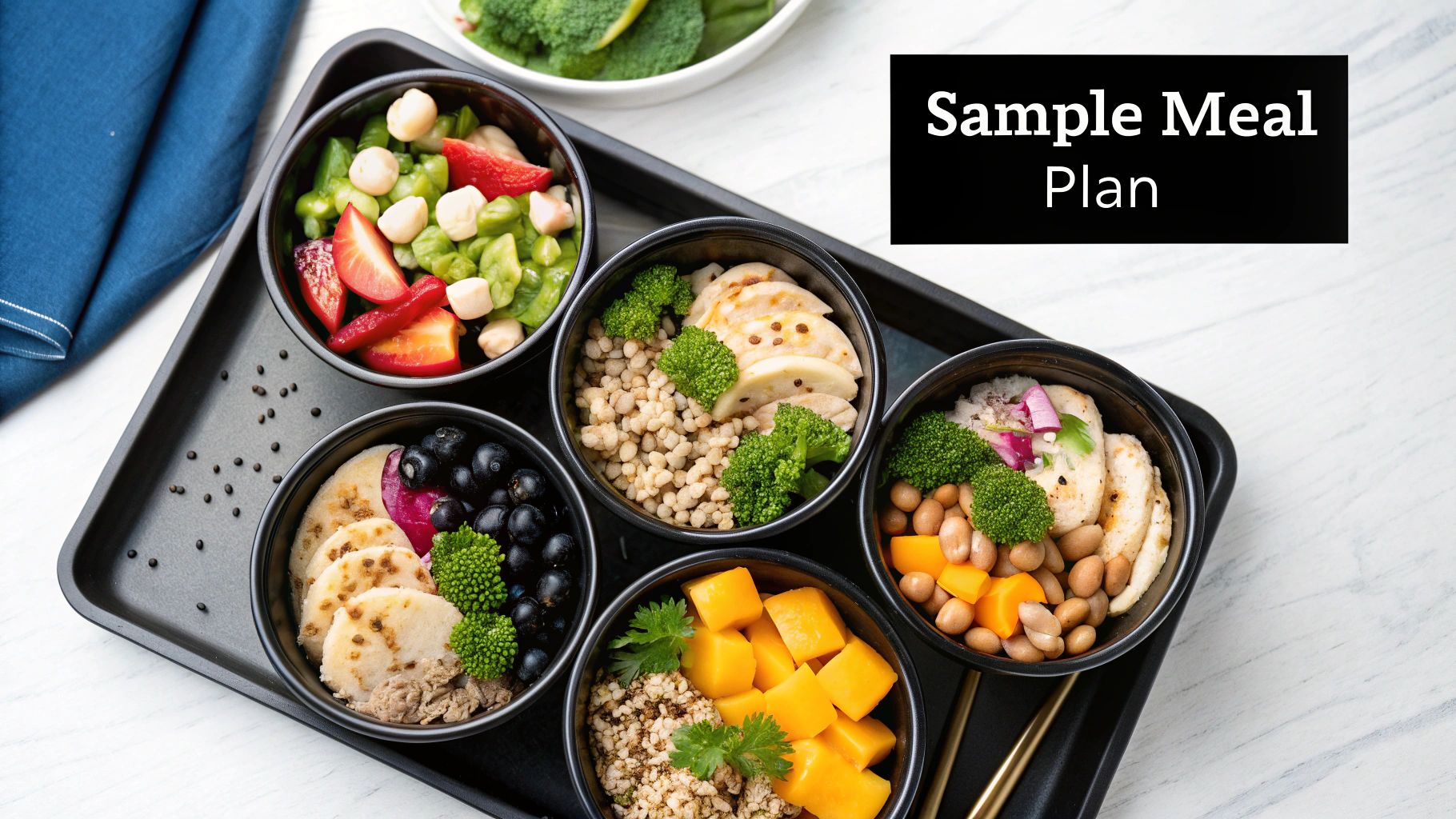
Starting a carb cycling plan is a great step, but even the most well-laid plans can run into trouble. Knowing the common hurdles before you hit them is your best line of defense. Think of this as your guide to navigating the tricky spots and keeping your fat loss journey on track.
One of the first things people often run into is that sluggish, drained feeling on low-carb days, sometimes called the "low-carb flu." This isn't just in your head; it's usually a sign that your electrolytes are out of whack or you're dehydrated. Cutting carbs makes your body shed water, and essential minerals like sodium and potassium go right along with it.
The fix? Be proactive. Add a pinch of good sea salt to your water on low-carb days and make sure you’re eating potassium-rich foods like avocado and leafy greens. And of course, staying on top of your water intake is absolutely non-negotiable.
Overeating on High-Carb Days
On the flip side, it's incredibly tempting to let high-carb days turn into all-out cheat days. That's a huge mistake. The whole point of these days is to strategically refill your muscle glycogen and give your metabolism a kick, not to undo all your hard work with a ton of processed junk.
You still need to hit your macros. The sheer volume of food might feel like a lot, but it’s crucial that those carbs come from clean, quality sources.
- Good Choices: Stick with things like sweet potatoes, oats, brown rice, and fruit.
- Foods to Limit: Steer clear of sugary drinks, candy, pastries, and other processed snacks that are all calories and no nutrition.
A high-carb day is a refuel, not a free-for-all. Treat it that way, and it'll work for you, not against you.
Cutting Fats Too Low
I see this all the time. People start a carb cycling plan and slash both carbs and fats on their low-carb days. This is a recipe for disaster. Your body needs healthy fats to produce hormones, including the ones that control your metabolism and keep you feeling full.
When your carbs are low, fat is your main fuel source. If you cut it too much, you’ll be left feeling hungry, exhausted, and foggy. Make sure you're hitting your fat target—around 0.3-0.4 grams per pound of body weight—every single day, no matter what your carbs look like.
Don't fear fat on your low-carb days. Sources like avocado, nuts, seeds, and olive oil are your allies. They provide sustained energy and help keep hunger at bay, making the entire process far more manageable.
Neglecting Fiber and Micronutrients
It’s easy to get tunnel vision on your macros and completely forget about the other important stuff. On low-carb days especially, it's common to accidentally cut way back on fiber when you eliminate fruits and whole grains.
Fiber is a game-changer for digestive health and feeling full, which is a massive help when you're in a deficit. Make a conscious effort to load your plate with non-starchy, fibrous vegetables.
- Broccoli
- Spinach
- Asparagus
- Cauliflower
- Bell Peppers
These veggies are packed with the micronutrients and fiber you need, all without piling on the carbs. They'll help you feel satisfied while supporting your overall health.
Remember that successful fat loss extends beyond just diet; other lifestyle factors play a huge role. For example, understanding the intricate relationship between sleep and your weight can be a game-changer for your results.
This structured flexibility is what makes carb cycling work so well for so many people. A comprehensive meta-analysis really drives this home, showing adherence rates were significantly higher on carb cycling, with 72% compliance at one year, compared to just 53% for ketogenic diets.
Critically, carb cycling participants also maintained their resting metabolic rate within 2% of their baseline, while traditional dieters saw declines of up to 9%, helping to prevent that dreaded metabolic slowdown.
Your Carb Cycling Questions, Answered
https://www.youtube.com/embed/tpNsPzu7poA
Even with the best plan in hand, you’re bound to have some questions pop up along the way. Let’s clear up some of the most common things people ask about carb cycling so you can feel confident in your approach.
How Long Should I Carb Cycle to Lose Fat?
Think of carb cycling as a focused fat-loss tool, not a forever diet. For most people, a dedicated phase of 8 to 16 weeks is the sweet spot. That’s enough time to get some serious results without feeling completely burned out.
Once you hit your target, the goal isn't to just stop. You'll want to shift gears into a maintenance phase. This usually means slowly bumping up your calories to find your new normal, which helps you lock in your progress for the long haul. Many people find they naturally continue matching carbs to their training days, just with a more generous calorie budget.
Can I Still Carb Cycle Without Tracking Macros?
Absolutely. While logging every gram of food is the fastest way to get predictable results, it’s not for everyone. You can definitely take a more intuitive route and still benefit from the core principles of carb cycling.
Here’s a simple way to approach it:
- On hard training days: Make a point to include starchy carbs with your meals. We're talking about things like potatoes, rice, oats, or quinoa.
- On rest days or light activity days: Skip the starches. Build your plates around lean protein, healthy fats, and fill up on non-starchy vegetables like leafy greens, broccoli, and bell peppers.
You might find your progress is a bit slower with this method, but for many, it’s a much more sustainable way to get started.
Consistency beats perfection every single time. Sticking to the plan—whether you're tracking meticulously or just focusing on food choices—is what ultimately gets you where you want to go.
What if I Accidentally Eat Carbs on a Low-Carb Day?
First off, take a deep breath. It’s not a big deal. A single off-plan meal or snack isn’t going to undo a week of hard work. The worst thing you can do is fall into the trap of trying to “compensate” by skipping your next meal or punishing yourself with extra cardio.
The best response is boringly simple: just get back on track. Acknowledge it happened, let it go, and make your very next meal a planned one. Your long-term consistency is what really matters, not one minor slip-up.
Is Cardio Necessary for Fat Loss on a Carb Cycling Plan?
Cardio isn't a requirement, but it can certainly help speed things up by burning extra calories. If you do decide to add it in, a little bit of strategy can go a long way.
Here’s how I like to time it for maximum effect:
- Low-Intensity Cardio: Things like walking or a slow jog are perfect for your low-carb days. Because your glycogen (stored carb) levels are low, your body is more inclined to burn fat for energy.
- High-Intensity Interval Training (HIIT): Save your all-out HIIT sessions for high-carb days. You’ll have the fuel in the tank to push hard, which is what makes HIIT so effective in the first place.
But remember, strength training should always be your number one priority. Lifting weights is the signal that tells your body to preserve precious muscle while you’re losing fat, which is key to keeping your metabolism fired up.
Ready to stop guessing and start seeing results? The AI Meal Planner creates personalized carb cycling plans based on your unique goals, taking all the complicated calculations off your plate.
AI-powered nutrition
Get Your Personalized Meal Plan
AI creates the perfect meals for your goals, lifestyle, and taste.
Start Your Journej
